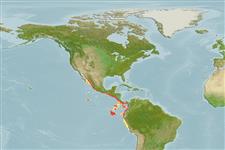Common names from other countries
Environment: milieu / climate zone / depth range / distribution range
Écologie
; profondeur 73 - 1454 m (Ref. 101379). Tropical, preferred 23°C (Ref. 107945); 28°N - 17°S, 112°W - 72°W
Eastern Pacific: southeast Gulf of California, Mexico to Mollendo, Peru.
Distribution in Guatemala possibly true based on native range although no reference for Guatemala has been found yet.
Length at first maturity / Taille / Poids / Âge
Maturity: Lm 11.7 range ? - ? cm Max length : 11.0 cm TL mâle / non sexé; (Ref. 8)
Relatively common; trawled at depths of 73 to 760 m and caught at an even deeper water localities up to 1454 m (Ref. 101379).
Life cycle and mating behavior
Maturité | Reproduction | Frai | Œufs | Fécondité | Larves
Members of the order Decapoda are mostly gonochoric. Mating behavior: Precopulatory courtship ritual is common (through olfactory and tactile cues); usually indirect sperm transfer.
Holthuis, L.B. 1980. (Ref. 8)
Statut dans la liste rouge de l'IUCN (Ref. 130435)
statut CITES (Ref. 108899)
Not Evaluated
Not Evaluated
Utilisations par l'homme
Pêcheries: commercial
| FishSource | Sea Around Us
Outils
Plus d'informations
Taille/ÂgeCroissanceLongueur-poidsLongueur-longueurMorphologieLarvesAbondance
Sources Internet
Estimates based on models
Preferred temperature
(Ref.
115969): 6.7 - 11.9, mean 9.3 (based on 54 cells).
Résilience
Haut, temps minimum de doublement de population inférieur à 15 mois (K=0.41-0.86).
